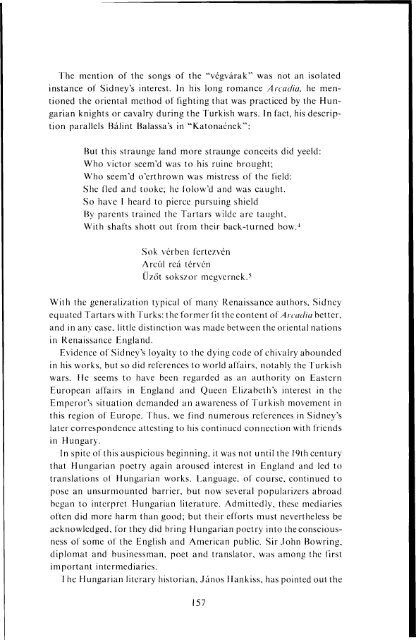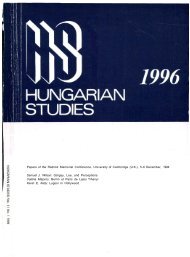terest in <strong>Hungarian</strong> literature, has been far more limited. We candiscern a vivid influence <strong>of</strong> <strong>Hungarian</strong> themes and point to significantGerman. Italian and French poets who have come under the spell <strong>of</strong><strong>Hungarian</strong> literature, or at least <strong>of</strong> a major <strong>Hungarian</strong> poet, but there isrelatively little <strong>Hungarian</strong> literary influence on England. This might beblamed on the distorted image <strong>of</strong> <strong>Hungarian</strong> literature among Englishmen,and also on sheer ignorance. Yet there have been at least threeperiods when active interest was shown in <strong>Hungarian</strong> literature.<strong>The</strong> first important reference to <strong>Hungarian</strong> poetry may be found inSir Philip Sidney's <strong>The</strong> Defense <strong>of</strong> Poesy (1595). As a diplomat, he hadtravelled to Vienna and thence to the outposts <strong>of</strong> the Imperial forces onthe Turkish frontier. This journey naturally took him into Hungary,specifically Pozsony (Bratislava), where he was the guest <strong>of</strong> a Dr.Purkircher; the French diplomat I.anguet had introduced them. AlthoughSidney's tutor assumed that the young man's visit would lastonly about three days, it lasted almost a month. 1 He met LazarusSchuendi, commander <strong>of</strong> the imperial forces in Hungary, and in visits tothe vegvdrak ( outpost fortresses) gathered a lasting impression aboutmilitary tactics and the life <strong>of</strong> soldiers in Hungary. Of a romantic andchivalric turn <strong>of</strong> mind, Sidney seems to have responded eagerly to thestimulus <strong>of</strong> this lifestyle.Even more than the military information he gathered, Sidney seemsto have valued his literary contacts. "In Hungary I have seen it themanner <strong>of</strong> all feasts, and suchlike meetings," he wrote in his Defense <strong>of</strong>Poesy, "to have songs <strong>of</strong> their ancestors' valor, which that right soldierlikenation think one <strong>of</strong> the chief kindlers <strong>of</strong> brave courage." 2 <strong>The</strong>context, it should be noted, was the discussion <strong>of</strong> lyrical poetry. Sidneydefended this genre against those moralists who saw only the work <strong>of</strong>the devil in the appeal to the emotions. He introduced his discussionwith these rhetorical questions:Is it the lyric that most displeaseth, who with his tuned and wellaccordedvoice giveth praise, the reward <strong>of</strong> virtue, to virtuous acts? whogiveth moral precepts and natural problems? who sometimes raiseth uphis voice to the height <strong>of</strong> heavens, in singing the lauds <strong>of</strong> the immortalGod? 3Thus, to Sidney, the appeal <strong>of</strong> these <strong>Hungarian</strong> songs was in their moraland patriotic tone and in their natural or "rude" style which, he felt,could be compared with the "Lacedaemonians." He conjured Pindar tosubstantiate his claim that victory in battle was to be celebrated overvictory at the tourney. In short, in his contemporary world, Sidneycould find heroic poetry that compared with the classical in dignity andnobility only in Hungary.
<strong>The</strong> mention <strong>of</strong> the songs <strong>of</strong> the "vegvarak" was not an isolatedinstance <strong>of</strong> Sidney's interest. In his long romance Arcadia, he mentionedthe oriental method <strong>of</strong> fighting that was practiced by the <strong>Hungarian</strong>knights or cavalry during the Turkish wars. In fact, his descriptionparallels Balint Balassa's in "Katonaenek":But this straunge land more straunge conceits did yeeld:Who victor seem'd was to his ruine brought;Who seem'd o'erthrown was mistress <strong>of</strong> the field:She fled and tooke; he folow'd and was caught.So have 1 heard to pierce pursuing shieldBy parents trained the Tartars wilde are taught.With shafts shott out from their back-turned bow. 4Sok verben fertezvenArcul rea tervenUzot sokszor megvernek. 5With the generalization typical <strong>of</strong> many Renaissance authors, Sidneyequated Tartars with Turks: the former fit the content o {Arcadia better,and in any case, little distinction was made between the oriental nationsin Renaissance England.Evidence <strong>of</strong> Sidney's loyalty to the dying code <strong>of</strong> chivalry aboundedin his works, but so did references to world affairs, notably the Turkishwars. He seems to have been regarded as an authority on EasternEuropean affairs in England and Queen Elizabeth's interest in theEmperor's situation demanded an awareness <strong>of</strong> Turkish movement inthis region <strong>of</strong> Europe. Thus, we find numerous references in Sidney'slater correspondence attesting to his continued connection with friendsin Hungary.In spite <strong>of</strong> this auspicious beginning, it was not until the 19th centurythat <strong>Hungarian</strong> poetry again aroused interest in England and led totranslations <strong>of</strong> <strong>Hungarian</strong> works. Language, <strong>of</strong> course, continued topose an unsurmounted barrier, but now several popularizers abroadbegan to interpret <strong>Hungarian</strong> literature. Admittedly, these mediaries<strong>of</strong>ten did more harm than good; but their efforts must nevertheless beacknowledged, for they did bring <strong>Hungarian</strong> poetry into the consciousness<strong>of</strong> some <strong>of</strong> the English and <strong>American</strong> public. Sir John Bowring,diplomat and businessman, poet and translator, was among the firstimportant intermediaries.<strong>The</strong> <strong>Hungarian</strong> literary historian, Janos Hankiss, has pointed out the
- Page 1 and 2: Canadian-American Review of Hungari
- Page 3 and 4: Canadian-American Review of Hungari
- Page 5 and 6: Canadian-American Review of Hungari
- Page 7 and 8: Canadian-American Review of Hungari
- Page 9 and 10: the best possible settlers who woul
- Page 11 and 12: than a decade later they were follo
- Page 13 and 14: Sociologists have yet to explain sa
- Page 15: fifteen minutes, and spent the rest
- Page 18 and 19: from the "Canadian poetry" of Icela
- Page 20 and 21: garian community of Western Canada,
- Page 22 and 23: lowed translations from other, more
- Page 24 and 25: which took place in the pages of th
- Page 27 and 28: from teaching in 1968, Kirkconnell
- Page 29 and 30: Magyar poets and writers to the rea
- Page 31 and 32: tive of his helpful attitude and un
- Page 33: 33. Kirkconnell, A Slice of Canada,
- Page 36 and 37: The groaning of the slaves on Egypt
- Page 38 and 39: ecause most such lines are imbedded
- Page 40 and 41: ;Two spheres contend with one anoth
- Page 42 and 43: matched it to this feeble hurdy-gur
- Page 44 and 45: NOTES1. The only full-length study
- Page 48 and 49: limitations of Bowring and others:
- Page 50 and 51: Jones' Five Hungarian WritersJ 4 Su
- Page 53 and 54: REVIEW ARTICLEHungarian Poetry in E
- Page 55 and 56: ooks written in English. A table of
- Page 57 and 58: passive, or into noun phrases in En
- Page 59 and 60: REVIEW ARTICLEHungarian Religious P
- Page 61 and 62: magas és a mély magánhangzójú
- Page 63 and 64: SPECIAL SECTIONToldiAn Epic Poem (1
- Page 65 and 66: CANTO ONE"He lifted, with one hand,
- Page 67 and 68: "Who should be squire of this whole
- Page 69 and 70: What meant this hubbub in a widow's
- Page 71 and 72: "Lad, here's your share! Don't say
- Page 73 and 74: The heavy stone flies on: where wil
- Page 75 and 76: The homes of moorhen, plover, gull
- Page 77 and 78: Perhaps I'll shed my blood, some no
- Page 79 and 80: CANTO FIVENicholas went wandering a
- Page 81 and 82: Her tongue was like a coulter in th
- Page 83 and 84: Rosemary pots mourned on its window
- Page 85 and 86: Such were her words. No more would
- Page 87 and 88: As if a nest of hornets rose to sti
- Page 89 and 90: Upon an isle, by a Czech's hand the
- Page 95 and 96: REVIEW ARTICLEQuo Vadis Transylvani
- Page 97 and 98:
Hungarians in Rumania in terms of t
- Page 99 and 100:
down by serious shortcomings in bot
- Page 101 and 102:
alanced presentation of the Vienna
- Page 104 and 105:
talent enables Wass to depict the s
- Page 106 and 107:
Carpathian Federation, and printed
- Page 108 and 109:
Now and then, however, this rule de
- Page 110 and 111:
temper such an indictment by recogn
- Page 112 and 113:
OUR CONTRIBUTORS (continued from pa
- Page 115:
TO THOSE WISHING TO SUBMIT MANUSCRI
















